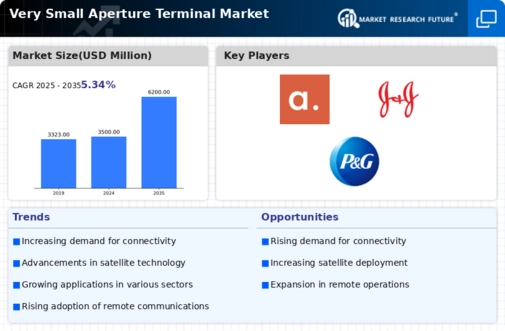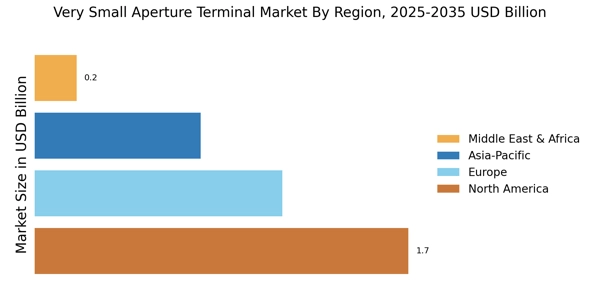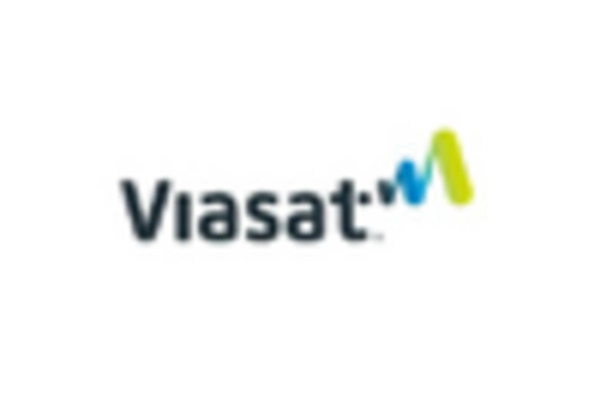Integration with IoT and Cloud Services
The integration of Very Small Aperture Terminal systems with Internet of Things (IoT) and cloud services is reshaping the landscape of the Very Small Aperture Terminal Market. As industries increasingly adopt IoT solutions for real-time data collection and analysis, the need for reliable satellite communication becomes paramount. VSAT technology facilitates seamless connectivity for IoT devices deployed in remote locations, enabling efficient data transmission to cloud platforms. This integration is particularly relevant in sectors such as agriculture, logistics, and smart cities, where real-time monitoring is essential. The market for IoT-enabled VSAT solutions is anticipated to grow significantly, driven by the increasing reliance on cloud-based applications and services.
Expansion of Satellite Communication Services
The expansion of satellite communication services is a pivotal driver for the Very Small Aperture Terminal Market. As satellite operators launch new satellites and enhance their coverage, the availability of VSAT services is increasing. This expansion is particularly evident in regions that have historically been underserved by terrestrial networks. The introduction of new frequency bands, such as Ka-band and Ku-band, is also contributing to the growth of the market, as these bands offer higher data rates and improved performance. The increasing number of satellite launches and the subsequent growth in service offerings are expected to propel the Very Small Aperture Terminal Market forward, creating new opportunities for service providers and end-users alike.
Rising Demand for Disaster Recovery Solutions
The need for robust disaster recovery solutions is becoming increasingly critical, thereby influencing the Very Small Aperture Terminal Market. In the face of natural disasters and emergencies, traditional communication infrastructure often fails, highlighting the importance of satellite communication systems. VSAT technology provides a reliable backup communication channel, ensuring continuity of operations for businesses and emergency services. The market for disaster recovery solutions is projected to expand, with organizations recognizing the value of having resilient communication systems in place. This trend is likely to drive investments in the Very Small Aperture Terminal Market, as stakeholders seek to enhance their preparedness for unforeseen events.
Growing Demand for Connectivity in Remote Areas
The demand for connectivity in remote and underserved regions is a significant driver for the Very Small Aperture Terminal Market. As businesses and governments seek to bridge the digital divide, VSAT technology offers a viable solution for providing internet access in areas where traditional infrastructure is lacking. According to recent estimates, nearly 3 billion people still lack internet access, highlighting a substantial market opportunity. The ability of VSAT systems to deliver reliable communication services in challenging environments positions the Very Small Aperture Terminal Market as a key player in addressing this connectivity gap. This trend is expected to continue, with investments in satellite communication infrastructure increasing to meet the growing demand.
Technological Advancements in Satellite Communication
The Very Small Aperture Terminal Market is experiencing a surge in technological advancements, particularly in satellite communication technologies. Innovations such as high-throughput satellites (HTS) and low Earth orbit (LEO) satellite constellations are enhancing the capabilities of VSAT systems. These advancements enable higher data rates and improved bandwidth efficiency, which are crucial for various applications, including remote sensing and telemedicine. The market is projected to grow at a compound annual growth rate (CAGR) of approximately 10% over the next five years, driven by these technological improvements. As a result, the Very Small Aperture Terminal Market is likely to witness increased adoption across sectors such as maritime, aviation, and energy, where reliable communication is essential.


















Leave a Comment